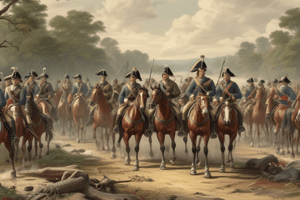Podcast
Questions and Answers
What did John Parker instruct his men to do before the confrontation with the British?
What did John Parker instruct his men to do before the confrontation with the British?
- Stand their ground and not fire unless fired upon. (correct)
- Fire at the approaching British troops.
- Form a defensive line with their weapons.
- Retreat immediately to safety.
What was the outcome of the first shot fired in Lexington?
What was the outcome of the first shot fired in Lexington?
- Its origin remains unknown and sparked immediate conflict. (correct)
- It was fired as a signal by John Parker.
- It was fired by a British soldier in error.
- It marked the official start of the American Revolution.
How did the British soldiers react after the first shot was fired?
How did the British soldiers react after the first shot was fired?
- They started firing aimlessly into the air.
- They fired a volley at the militia. (correct)
- They retreated without engaging.
- They attempted to negotiate a truce.
What was found by the British troops in Concord?
What was found by the British troops in Concord?
What tactics did the militiamen use when attacking the retreating British soldiers?
What tactics did the militiamen use when attacking the retreating British soldiers?
How many British soldiers were killed during the conflict?
How many British soldiers were killed during the conflict?
What happened to Samuel Adams and John Hancock during the events in Lexington and Concord?
What happened to Samuel Adams and John Hancock during the events in Lexington and Concord?
Which phrase best describes the initial intent of the militia in Lexington according to John Parker?
Which phrase best describes the initial intent of the militia in Lexington according to John Parker?
Flashcards are hidden until you start studying
Study Notes
The Shot Heard ’Round the World
- April 19, 1775: The first shots of the American Revolution were fired in Lexington, Massachusetts.
- Lexington militia: 80 armed men lined up in formation, wary of a potential conflict with British troops.
- John Parker: The leader of the Lexington militia instructed his men to stand their ground and not fire first, but be prepared to fight.
- Unclear who fired the first shot: The British soldiers believed the militia opened fire first, but the militia denied this claim.
- Potential causes for the first shot: The shot may have been fired by an individual, not part of the militia, to sound an alarm.
- Immediate aftermath: The British soldiers, perceiving themselves under attack, responded with a volley of fire, sparking immediate fighting.
- Casualties in Lexington: Eight militia members were killed, nine wounded, and only one British soldier was injured.
- The British move to Concord: The British soldiers marched to Concord, hoping to seize military supplies.
- Word spreads: News of the fighting in Lexington prompted a rapid response from the local colonial militia, who gathered to confront the British.
- Skirmish at North Bridge: Colonist militia confronted British troops at North Bridge, leading to additional gunfire.
- British retreat: The British, facing growing colonial resistance, retreated to Boston.
- Colonial ambush: The militia fired on the retreating British soldiers from behind trees and stone walls.
- High British casualties: By the time the British reached Boston, 73 soldiers were killed and 174 were wounded.
- Colonial losses: The colonists sustained 49 fatalities and 39 injuries.
- Strategic failure for the British: The British failed to capture Samuel Adams and John Hancock, key figures in the revolutionary movement.
Studying That Suits You
Use AI to generate personalized quizzes and flashcards to suit your learning preferences.



